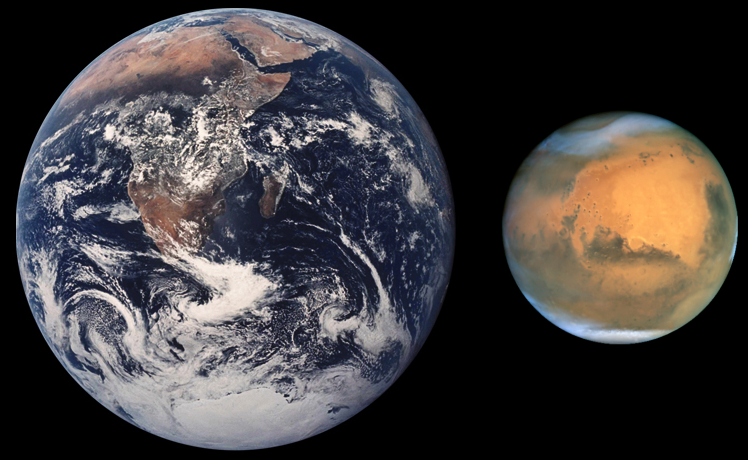Witajcie. Tym razem czas na czwartą planetę naszego Układu Słonecznego - Marsa.
Hello. It's time for the fourth planet in our Solar System - Mars.

Z obrazów i danych przesłanych przez sondy kosmiczne wynika, że Mars jest pustynną planetą o surowym klimacie. A jednak to Czerwona Planeta pozostaje głównym celem poszukiwań życia pozaziemskiego.
From images and data sent by space probes, it appears that Mars is a desert planet with a harsh climate. And yet this Red Planet remains the main goal of the search for extraterrestrial life.
Nieziemski Świat. Mars kiedyś i dziś.
Unearthly World. Mars once and today.

Klimat na Marsie jest bardzo surowy. Zimą na biegunach temperatura spada do -125 stopni Celsjusza, a latem na równiku osiąga 17 stopni. Atmosfera planety mimo, że zbudowana z dwutlenku węgla to jednak zbyt cienka by pozwolić zatrzymać ciepło jak na Wenus. Cztery i pół miliarda lat temu Mars był zupełnie inną planetą. Miał gęstszą atmosferę i panowały na nim wystarczająco wysokie temperatury by woda występowała w stanie ciekłym. Ze śladów wielu kanałów, koryt rzecznych i kanionów oraz wyników analizy składu chemicznego Marsjańskich meteorytów wynika, że kiedyś na Marsie musiały płynąć duże ilości wody. Gdzie się ona podziała? To zagadka. Dziś stanowi jedynie składnik czap polarnych i atmosfery planety.
The climate on Mars is very harsh. In winter, the temperature drops to -125 * C in winter, and in the summer at the equator it reaches 17 * C. The atmosphere of the planet, though built of carbon dioxide, is too thin to allow it to stay warm as for Venus. Four and a half billion years ago, Mars was a completely different planet. It had a denser atmosphere and the temperature was high enough for the water to be in a liquid state. From the traces of many channels, river channels and canyons, and the results of the analysis of the chemical composition of Martian meteorites, it appears that once on the Mars large amounts of water had to flow. Where did it go? It's a puzzle. Today it is only an element of the polar cap and the atmosphere of the planet.
Północny biegun Marsa pod koniec zimy (po lewej) i latem (po prawej).
North pole of Mars at the end of winter (left) and summer (right)

Wewnątrz Marsa.
Inside of Mars.

Mars przypomina budową Ziemię: pod skorupą znajduje się gruby płaszcz, a w głębi planety jądro, złożone głównie z żelaza.
Mars resembles the construction of the Earth: under the shell there is a thick coat, and in the depths of the planet the nucleus, composed mainly of iron.
Porównanie wielkości Ziemi i Marsa.
Comparison of the size of the Earth and Mars.

Średnica Marsa wynosi 6794 km co odpowiada trochę ponad połowie średnicy Ziemi. Jego gęstość jest mniejsza i przy tej wielkości jego masa wynosi 11% masy Ziemi. Rok Marsjański jest równy 687 dni ziemskich. Doba słoneczna na Marsie jest niewiele dłuższa niż ziemska i ma 24 godziny, 39 minut i 35 sekund.
The diameter of the Mars is 6794 km, which corresponds to slightly more than half the diameter of the Earth. Its density is smaller and at its size its mass is 11% of the Earth's mass. The year on Mars lasts 687 earth days. Solar day on Mars is not much longer than terrestrial and has 24 hours, 39 minutes and 35 seconds.
Obraz powierzchni Marsa.
Image of Mars surface.

Mars jest najbardziej znaną nam planetą układu słonecznego. Wysłano wiele sond które wylądowały i dały wiele zdjęć tego niesamowitego świata. Jak widać Mars ma pustynna powierzchnię często usłaną kamieniami.
Mars is the planet's most known solar system. Many probes have landed and have given many pictures of this amazing world. As you can see, Mars has a desert surface often strewn with stones.

Ciekawostką jest to, że koszt wysłania z Ziemi na Marsa 1 kg ładunku to obecnie około 310 tysięcy dolarów. Ze względów ekonomicznych NASA planuję wysłanie człowieka na Marsa dopiero po 2030 roku. Mam nadzieję, że będzie mi dane dożyć tej chwili gdy człowiek stanie na Czerwonej Planecie.
An interesting fact is that the cost of sending 1 kg of cargo from Mars to Mars is currently around $ 310,000. For economic reasons, NASA plans to send a man to Mars after 2030. I hope that I will be able to live to this moment when a man stands on the Red Planet.
Na zakończenie mój amatorski filmik Marsa z teleskopu.
At the end of my amateur video. Mars from telescope.
Źródło fotografii / Photo source : NASA
All rights reserved by @astromaniak 2017
Follow, Upvote & Resteem Please:) Thanks:)
Jakiego teleskopu używasz?
To było z newtona 8'', a tak to GSO 12''.
Ale jak idziesz po kolei, to zapomniałeś o trzeciej planecie :)
No Można by Ziemię opisać, ale odpuściłem :D Skupię się na tym co nie znane:)